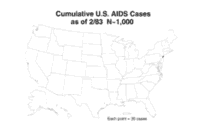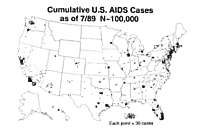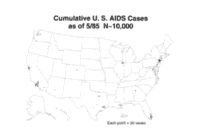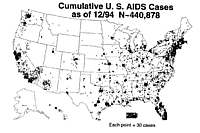
|
 |
| |
An Expanding Public Health ThreatThe United StatesAs of September 30, 1996, the Centers for Disease Control and Prevention (CDC) had received reports of 566,002 cases of AIDS among persons in the U.S. and more than 343,000 of these persons have been reported to have died as a result of complications related to HIV. Since 1987, AIDS has risen from being the 15th leading cause of death among all Americans to the 8th. AIDS is now the leading cause of death among Americans aged 25 to 44 (See Figure 1). In 1995 alone, approximately 74,180 new cases of AIDS were reported in the U.S. and more than 46,000 AIDS-related deaths were reported to the CDC in 1994. CDC estimates that between 40,000 and 60,000 Americans are becoming newly infected with HIV each year, and that between 650,000 and 900,000 Americans are currently living with HIV. As the epidemic in the United States has expanded, the demographics of the epidemic have changed. The early years of the epidemic were dominated by cases involving gay or bisexual men living in major urban centers (e.g., New York, San Francisco, and Los Angeles). Today, this group represents less than half of all new cases, although it still represents a majority of persons living with HIV and AIDS. Among the populations that are heavily affected today are young gay and bisexual men (including gay and bisexual men of color), women, and injecting drug users and their sexual partners as well as users of non-injecting drugs (e.g., crack cocaine and alcohol). In 1995, nearly 14,000 women were reported to CDC as having been diagnosed with AIDS. Women now comprise 14 percent of cumulatively reported AIDS cases. If this trend continues, it is estimated that 80,000 American children will have been orphaned as a result of AIDS by the end of this decade. In 1995, 800 new cases of pediatric AIDS were reported.[1] Adolescents are increasingly at risk for HIV infection. CDC estimates that one-quarter of new HIV infections in the U.S. occur among young people under age 21. A significant number of young people are engaging at earlier ages in sexual intercourse and drug and alcohol use. This fact, coupled with the disturbing number of adolescents who are prone to high-risk behavior due to homelessness, sexual abuse, and other circumstances, makes young Americans extremely vulnerable to HIV infection. Racial and ethnic minorities have been disproportionately affected by the epidemic of HIV and AIDS. African Americans, who represent approximately 12 percent of the U.S. population, accounted for 40 percent of newly reported AIDS cases in 1995. Hispanics, who account for about 9 percent of the general population, represented 19 percent of new cases reported in 1995. The number of African Americans and Hispanics affected by HIV and AIDS has risen dramatically. In 1982, African Americans and Hispanics represented 34 percent of all AIDS cases; however, as of December 1995, these groups comprised 52 percent of cumulative AIDS cases. The HIV epidemic continues to spread into suburban and rural areas, with dramatic increases in certain regions of the South and Midwest. Between January 1993 and October 1995, the largest number of AIDS cases (86,462) were reported from the South.[2] While most cases are still reported from urban areas, the rate of reported cases in non-metropolitan areas is increasing more rapidly than in urban areas. AIDS cases now have been reported in all 50 States, the District of Columbia, Puerto Rico, Guam, and each of the U.S. Territories (See Figure 2). The average lifetime cost of medical care after an HIV diagnosis is $119,000.[3] People living with HIV are often dependent on the public sector for their health care, particularly in the later stages of HIV disease. More than 50 percent of people living with AIDS are enrolled in Medicaid, including more than 90 percent of children with AIDS. In FY 1996, the Federal government spent an estimated $1.8 billion on Medicaid benefits for people living with HIV and AIDS and another $690 million on Medicare benefits. Social Security benefits for people disabled by HIV/AIDS totaled nearly $980 million in FY 1996. Many Federal programs such as Housing Opportunities for Persons with AIDS (HOPWA) and CDC's prevention efforts contribute to reducing the short- and long-term economic costs of the epidemic.
Figure 2 |
 |  |
 |  |
Globally, the toll of the epidemic is much greater and threatens to reverse decades of economic and public health progress in developing countries. The Joint United Programme on HIV and AIDS (UNAIDS) and the World Health Organization (WHO) estimate that 27.9 million people have been infected with HIV. As of mid-1995, approximately 14 million people were living with HIV. (See Figure 3)
Internationally, it is estimated that over 80 percent of HIV infections in adults have been transmitted through unprotected sexual intercourse. Heterosexual intercourse accounts for more than 70 percent of all adult HIV infections to date and homosexual intercourse for a further 5 to 10 percent.
Transfusion of HIV-infected blood or blood products accounts for approximately 4 percent of all adult HIV infections worldwide, and the sharing of HIV-infected injection equipment by drug users accounts for 5 to 10 percent of all adult HIV infections around the world. Mother-to-child transmission accounts for more than 90 percent of all infections in infants and children.
|
|
As in the U.S., the health care costs for people with HIV/AIDS in the rest of the world are significant. Some countries currently spend one-quarter to one-half of their health budgets on AIDS-related care, with studies indicating that this could rise to as much as 80 percent in parts of Africa and Asia by the year 2010. In addition, the HIV/AIDS epidemic has contributed to the emergence of a major secondary epidemic of tuberculosis, placing increasing burdens on health care delivery systems.
Since the beginning of the pandemic, 7.7 million people, including 1.6 million children, have been diagnosed with AIDS. The majority of newly infected adults are between 15 and 24 years old. By the year 2000, WHO projects that between 30 and 40 million people will have been infected with HIV and 10 to 15 million children will be orphaned due to AIDS.
President and First Lady | Vice President and Mrs. Gore
Record of Progress | The Briefing Room
Gateway to Government | Contacting the White House
White House for Kids | White House History
White House Tours | Help | Text Only
| The National AIDS Strategy, Introduction |